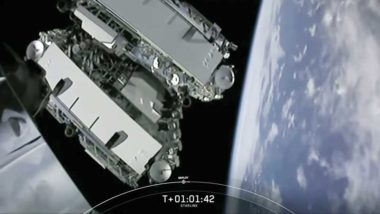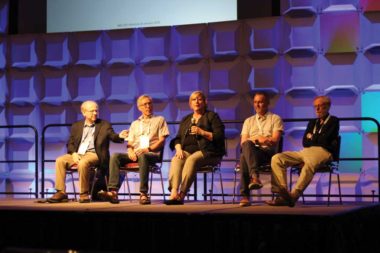Starlink vs. the astronomers – SpaceNews
On the evening of Jan. 6, a SpaceX Falcon 9 lifted off from Cape Canaveral and, an hour later, deployed its payload: 60 Starlink satellites. Those satellites joined 120 other satellites launched last May and November as SpaceX seeks to accelerate deployment of its initial broadband constellation, putting as many as 1,500 such satellites into orbit in 2020 alone.
About 36 hours after deployment, those satellites were visible to any attendees of the 235th Meeting of the American Astronomical Society (AAS) in Honolulu who ventured outside in the predawn hours Jan. 8. Despite the bright city lights, the satellites were easily visible through a hole in the clouds, dozens of bright objects speeding from west to east in a single line.
It’s not clear how many conference attendees tried to view the satellites, but later that morning many attended a special session at the conference about the effects Starlink satellites, and megaconstellations in general, have on their field. Since the first Starlink satellites launched in May, astronomers have complained that those satellites, and potentially other systems to be launched in the next few years, could make it far more difficult for astronomers to conduct observations using ground-based telescopes.
Satellites interfering with astronomical observations is not a new phenomenon. “Any object in Earth orbit that reflects sun, anything with an albedo greater than zero, can possibly leave a trail in an astronomical image,” said Pat Seitzer, a professor emeritus of astronomy at the University of Michigan.
On any given night, he said, hundreds of objects might pass in view of an observatory. “We’d really like no satellites,” he said, “but that battle was lost a long time ago, beginning in 1957.”
What sets Starlink apart is their magnitude, both in terms of number and brightness. When initially launched into parking orbits at an altitude of about 300 kilometers, they have a visual magnitude of between two or three: bright enough to be easily seen by the naked eye, even in a light-polluted city. By the time they get to their operational orbit of 550 kilometers, they dim to about fifth magnitude, visible to the naked eye only in much darker skies away from cities.
However, even at fifth magnitude the satellites are bright enough to pose a problem for professional astronomers who require long exposures on large telescopes to observe faint celestial objects. Seitzer said that, before Starlink, only about 200 objects in Earth orbit were that bright, but by the end of 2020 that could increase by a factor of nine because of Starlink. “So, life is going to get really interesting,” he said.
While astronomers may have been aware that SpaceX was planning to launch Starlink satellites, they didn’t expect them to be that bright. “What caught everyone, principally, by surprise was the sheer brightness of the ‘string of pearls’ going across the sky,” said Jeff Hall, director of the Lowell Observatory in Arizona and chair of an AAS committee that handles light pollution and space debris issues.

SpaceX says it was also surprised. “We certainly knew this was a novel spacecraft design in a novel architecture, but the level of brightness and visibility was a surprise to us,” said Patricia Cooper, vice president of satellite government affairs at SpaceX, who represented the company at the AAS meeting. SpaceX hasn’t disclosed many technical details about the Starlink satellites. The satellites, Cooper said, are “the product of a highly iterative design process” intended to minimize the volume of each spacecraft and thus maximize the number of satellites that can be launched on a single Falcon 9. Each satellite weighs 260 kilograms and has four phased-array antennas facing the Earth and a single solar array deployed above the satellite.
Cooper said the company spent months understanding why the Starlink satellites appeared so bright. Part of it, she said, had to do with the configuration of that solar array, particularly when each satellite is raising its orbit and the array is moved to a “low drag” position that increases its reflectivity as seen from the ground.
The satellite’s unique design also played a role. “What’s contributed to the brightness doesn’t seem intuitive,” she said. “It turns out, we think, that surfaces that scatter light, or that reflect light diffusely, may also be significant contributors.”
Testing a solution
Now that SpaceX believes it understands what makes the Starlink satellites so bright, it is testing ways to make them less reflective. One of the 60 satellites on that Jan. 6 launch is coated with “various darkening treatments,” Cooper said, intended to make it less reflective. “The goal is to work with the astronomy community to observe and measure the effectiveness of these coatings.”
It may be a few months, though, before astronomers know how effective this “DarkSat” is. Seitzer said it won’t be until at least late February, the earliest when that satellite would reach its final orbit, before astronomers can compare it to other Starlink satellites. SpaceX, meanwhile, will also have to see how those coatings affect the thermal properties of the satellite.
Thus, it may be months before SpaceX decides whether to apply those coatings to all future Starlink satellites or to fly other experimental DarkSats. In the meantime, the company plans to launch more unmodified satellites, with the next set of 60 to launch Jan. 20. “We tend to work very quickly. We tend to test, learn and iterate pretty rapidly,” Cooper said, declining to state how long the company thought it would take to come up with a permanent solution.
The company has remained in contact with an AAS working group established shortly after the May 2019 Starlink launch. That’s included monthly teleconferences, said Hall, who leads the working group, as well as an in-person meeting during the AAS conference. Those meetings initially focused on understanding SpaceX’s deployment plans, he said, and more recently on getting updates on SpaceX’s experiments to try and mitigate the brightness of its satellites.
While some in the astronomy community have sharply criticized SpaceX, particularly in social media, Hall said his group’s discussions with the company have been cordial. “We have not had to cajole SpaceX in any way. They’ve been very receptive, very proactive,” he said.
Emotions, though, still run high. During a press briefing after the conference session, Ethan Siegel, an astronomer who now writes for Forbes, criticized the AAS for talking with SpaceX while the company is still launching unmodified satellites, even comparing it to appeasement of Nazi Germany prior to the start of World War II. “Are we Elon Musk’s Neville Chamberlain?” he asked.
Hall defended those discussions. “There is no advantage or upside for distrusting what SpaceX colleagues have told us,” he said. “We will simply take them at face value and work as best as we can, and honestly, with them to try and resolve the situation.”
He said he believed SpaceX when it said it supports astronomy, a point Cooper made in her conference presentation. “We at SpaceX really value the science that you are undertaking, and we are committed to ensuring that we won’t impede it,” she said.
“Cheer up, the worst is yet to come”
While SpaceX and the AAS said they’ve worked well together to try and mitigate the brightness of the Starlink satellites, they haven’t made clear by how much their brightness would have to decrease in order to be considered at least acceptable by astronomers. Hall said his committee was working with SpaceX to try to identify the “targets they will need to hit” on reducing the brightness of the Starlink satellites but he didn’t specify those targets.

One initial goal is to make the satellites dim enough not to be visible to the naked eye. “One of the lowest rungs to meet in this complicated mix of impacts is naked-eye visibility,” Cooper said. “I think we’re confident we can reach that point.”
That would, at the very least, address some of the broader public concerns about the effect Starlink has on the night sky, which some astronomers raised during the AAS conference session. “The night sky itself is a cultural artifact,” said Chris Impey, a professor of astronomy at the University of Arizona. “It seems terribly shortsighted and, essentially, technologically arrogant to assume that there’s no cultural impact.”
Ruskin Hartley, executive director of the International Dark-Sky Association (IDA), said at the conference that protecting the night sky from the visual impact of satellites like Starlink has become a major priority for his organization. “IDA represents the people who want to have that experience of being presented with nature in its raw beauty,” he said.
A survey of IDA members, he said, showed they were “deeply concerned” about what will happen to the appearance of the night sky should the full Starlink constellation, and others, be deployed. He agreed that the satellites should be too dim to see with the naked eye and called on “shared stewardship” of the sky among all companies planning satellite constellations to limit their visual impact.
“The night sky is the ultimate public good. It is our ultimate commons,” Hartley said. “No one individual can protect it and, on the flip side, no one individual should be allowed to despoil it.”
Even if Starlink satellites, and those from other constellations, are made dark enough not to be visible with the naked eye, they could still be bright enough to pose challenges for professional astronomers.
“The first goal, the first threshold, is to get them below naked-eye visibility,” Seitzer said. “The second threshold is to get them below saturation effects on these large telescopes,” or the point where passing satellites no longer overwhelm an observatory’s instruments. However, those limits vary from telescope to telescope, making it difficult to come up with a single limit.
Even SpaceX Chief Executive Elon Musk has weighed on about the brightness of Starlink through his preferred medium, Twitter. “We’ve had good discussions with leading astronomers,” he tweeted Jan. 14. “One way or another, we’ll make sure Starlink doesn’t inhibit new discoveries or change the character of the night sky.”
While Starlink has received most of the attention, astronomers are aware of potential issues with other constellations. OneWeb has six satellites in orbit launched last year, which at eighth magnitude are too dim to see with the naked eye. “They are an issue, though, for large telescopes, and we’ll have to model that precisely,” Seitzer said. He added that the satellites are in higher orbits than Starlink, which makes them dimmer but also means they’re visible for longer each night.
With OneWeb scheduled to begin full-scale deployment of its constellation in February, Hall said the AAS has reached out to them to better understand their impacts on astronomy, with an initial meeting planned later in January.
But there are many more proposed systems, each with the potential of changing the character of the night sky. Not all will be deployed, Seitzer said, but astronomers have to assume that at least some will make it to orbit. “Praying for failure is not an option that the astronomical community should rely on,” he said. “As I like to say, cheer up, the worst is yet to come.”
This article originally appeared in the Jan. 20, 2020 issue of SpaceNews magazine.






